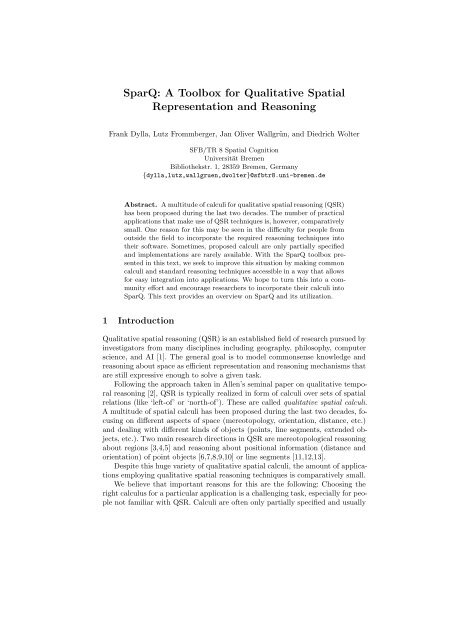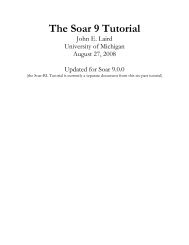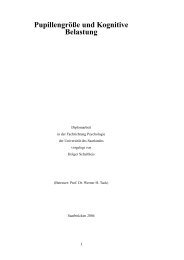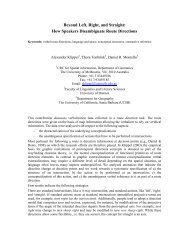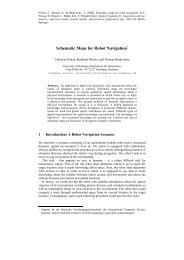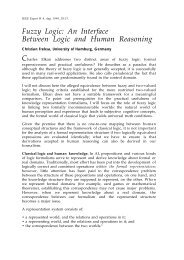SparQ: A Toolbox for Qualitative Spatial Representation and ...
SparQ: A Toolbox for Qualitative Spatial Representation and ...
SparQ: A Toolbox for Qualitative Spatial Representation and ...
You also want an ePaper? Increase the reach of your titles
YUMPU automatically turns print PDFs into web optimized ePapers that Google loves.
<strong>SparQ</strong>: A <strong>Toolbox</strong> <strong>for</strong> <strong>Qualitative</strong> <strong>Spatial</strong><br />
<strong>Representation</strong> <strong>and</strong> Reasoning<br />
Frank Dylla, Lutz Frommberger, Jan Oliver Wallgrün, <strong>and</strong> Diedrich Wolter<br />
SFB/TR 8 <strong>Spatial</strong> Cognition<br />
Universität Bremen<br />
Bibliothekstr. 1, 28359 Bremen, Germany<br />
{dylla,lutz,wallgruen,dwolter}@sfbtr8.uni-bremen.de<br />
Abstract. A multitude of calculi <strong>for</strong> qualitative spatial reasoning (QSR)<br />
has been proposed during the last two decades. The number of practical<br />
applications that make use of QSR techniques is, however, comparatively<br />
small. One reason <strong>for</strong> this may be seen in the difficulty <strong>for</strong> people from<br />
outside the field to incorporate the required reasoning techniques into<br />
their software. Sometimes, proposed calculi are only partially specified<br />
<strong>and</strong> implementations are rarely available. With the <strong>SparQ</strong> toolbox presented<br />
in this text, we seek to improve this situation by making common<br />
calculi <strong>and</strong> st<strong>and</strong>ard reasoning techniques accessible in a way that allows<br />
<strong>for</strong> easy integration into applications. We hope to turn this into a community<br />
ef<strong>for</strong>t <strong>and</strong> encourage researchers to incorporate their calculi into<br />
<strong>SparQ</strong>. This text provides an overview on <strong>SparQ</strong> <strong>and</strong> its utilization.<br />
1 Introduction<br />
<strong>Qualitative</strong> spatial reasoning (QSR) is an established field of research pursued by<br />
investigators from many disciplines including geography, philosophy, computer<br />
science, <strong>and</strong> AI [1]. The general goal is to model commonsense knowledge <strong>and</strong><br />
reasoning about space as efficient representation <strong>and</strong> reasoning mechanisms that<br />
are still expressive enough to solve a given task.<br />
Following the approach taken in Allen’s seminal paper on qualitative temporal<br />
reasoning [2], QSR is typically realized in <strong>for</strong>m of calculi over sets of spatial<br />
relations (like ‘left-of’ or ‘north-of’). These are called qualitative spatial calculi.<br />
A multitude of spatial calculi has been proposed during the last two decades, focusing<br />
on different aspects of space (mereotopology, orientation, distance, etc.)<br />
<strong>and</strong> dealing with different kinds of objects (points, line segments, extended objects,<br />
etc.). Two main research directions in QSR are mereotopological reasoning<br />
about regions [3,4,5] <strong>and</strong> reasoning about positional in<strong>for</strong>mation (distance <strong>and</strong><br />
orientation) of point objects [6,7,8,9,10] or line segments [11,12,13].<br />
Despite this huge variety of qualitative spatial calculi, the amount of applications<br />
employing qualitative spatial reasoning techniques is comparatively small.<br />
We believe that important reasons <strong>for</strong> this are the following: Choosing the<br />
right calculus <strong>for</strong> a particular application is a challenging task, especially <strong>for</strong> people<br />
not familiar with QSR. Calculi are often only partially specified <strong>and</strong> usually
no implementation is made available—if the calculus is implemented at all <strong>and</strong><br />
not only investigated theoretically. As a result, it is not possible to “quickly” evaluate<br />
how different calculi per<strong>for</strong>m in practice. Even if an application developer<br />
has decided on a particular calculus, he has to invest serious ef<strong>for</strong>ts to include<br />
the calculus <strong>and</strong> required reasoning techniques into the application. For many<br />
calculi this is a time-consuming <strong>and</strong> error-prone process (e.g. involving writing<br />
down huge composition tables, which are often not even completely specified in<br />
the literature).<br />
Overall, we are convinced that the QSR community should strive <strong>for</strong> making<br />
the fruits of its work available to the public in a homogeneous framework.<br />
We have thus started the development of a qualitative spatial reasoning toolbox<br />
called <strong>SparQ</strong> 1 that aims at supporting the most common tasks—qualification,<br />
computing with relations, constraint-based reasoning, etc. (cp. section 3)—<strong>for</strong> an<br />
extensible set of spatial calculi. A complementary approach aiming at the specification<br />
<strong>and</strong> investigation of the interrelations between calculi has been described<br />
in [14]. Here, the calculi are defined in the algebraic specification language CASL.<br />
In contrast, our focus is on providing an implementation of QSR techniques that<br />
is tailored towards the needs of application developers. In its current version,<br />
<strong>SparQ</strong> mainly concentrates on calculi from the area of reasoning about the orientation<br />
of point objects or line segments. However, specifying <strong>and</strong> adding new<br />
calculi is in most cases very simple. We hope to turn this into a community ef<strong>for</strong>t,<br />
encouraging researchers from other groups to incorporate their own calculi.<br />
In this text, we describe <strong>SparQ</strong> <strong>and</strong> its utilization. The current version of<br />
<strong>SparQ</strong> <strong>and</strong> further documentation will be made available at the <strong>SparQ</strong> homepage<br />
2 . The next section briefly recapitulates the relevant terms concerning QSR<br />
<strong>and</strong> spatial calculi as needed <strong>for</strong> the remainder of the text. In section 3, we describe<br />
the services provided by <strong>SparQ</strong>. Section 4 explains how new calculi can be<br />
be incorporated into <strong>SparQ</strong> <strong>and</strong> section 5 describes how <strong>SparQ</strong> can be integrated<br />
into own applications.<br />
2 Reasoning with qualitative spatial relations<br />
A qualitative spatial calculus defines operations on a finite set R of spatial<br />
relations. The spatial relations are defined over a particular set of spatial objects,<br />
the domain D (e.g. points in the plane, oriented line segments, etc.). While<br />
a binary calculus deals with binary relations R ⊆ D × D, a ternary calculus<br />
operates with ternary relations R ⊆ D × D × D.<br />
A spatial calculus establishes a set of typically jointly exhaustive <strong>and</strong> pairwise<br />
disjoint (JEPD) base relations BR. The set R of all relations considered by the<br />
calculus contains at least the base relations, the empty relation ∅, the universal<br />
relation U, <strong>and</strong> the identity relation Id; the set R should be closed under the<br />
1 <strong>Spatial</strong> Reasoning done <strong>Qualitative</strong>ly<br />
2 http://www.sfbtr8.uni-bremen.de/project/r3/sparq/
operations defined in the following. Typically, the powerset of the base relations<br />
2 BR is chosen <strong>for</strong> R. 3<br />
As the relations are subsets of tuples from the same Cartesian product, the<br />
set operations union, intersection, <strong>and</strong> complement can be directly applied:<br />
Union: R ∪ S = { x | x ∈ R ∨ x ∈ S }<br />
Intersection: R ∩ S = { x | x ∈ R ∧ x ∈ S }<br />
Complement: R = U \ R = { x | x ∈ U ∧ x �∈ R }<br />
where R <strong>and</strong> S are both n-ary relations on D. The other operations depend on<br />
the arity of the calculus.<br />
2.1 Operations <strong>for</strong> binary calculi<br />
For binary calculi, two other important operations are required:<br />
Converse: R � = { (y, x) | (x, y) ∈ R }<br />
(Strong) composition: R ◦ S = { (x, z) | ∃y ∈ D : ((x, y) ∈ R ∧ (y, z) ∈ S) }<br />
For some calculi no finite set of relations exists that includes the base relations<br />
<strong>and</strong> is closed under composition as defined above. In this case, a weak<br />
composition is defined instead that takes the union of all base relations that have<br />
a non-empty intersection with the result of the strong composition:<br />
Weak composition: R ◦weak S = { d | T ∈ BR ∧ d ∈ T ∧ T ∩ (R ◦ S) �= ∅ }<br />
2.2 Operations <strong>for</strong> ternary calculi<br />
While there is only one possibility to permute the two objects of a binary relation<br />
which leads to the converse operation, there exist 5 such permutations <strong>for</strong> the<br />
three objects of a ternary relation. This results in the following operations 4 [15]:<br />
Inverse: INV(R) = { (y, x, z) | (x, y, z) ∈ R }<br />
Short cut: SC(R) = { (x, z, y) | (x, y, z) ∈ R }<br />
Inverse short cut: SCI(R) = { (z, x, y) | (x, y, z) ∈ R }<br />
Homing: HM(R) = { (y, z, x) | (x, y, z) ∈ R }<br />
Inverse homing: HMI(R) = { (z, y, x) | (x, y, z) ∈ R }<br />
Composition <strong>for</strong> ternary calculi is defined accordingly to the binary case:<br />
(Strong) comp.: R ◦ S = { (w, x, z) | ∃y ∈ D : ((w, x, y) ∈ R ∧ (x, y, z) ∈ S) }<br />
Other ways of composing two ternary relations can be expressed as a combination<br />
of the unary permutation operations <strong>and</strong> the composition [16] <strong>and</strong> thus do<br />
not have to be defined separately. The definition of weak composition is identical<br />
to the binary case.<br />
3 Unions of relations correspond to disjunction of relational constraints <strong>and</strong> thus we<br />
will often simply speak of disjunctions of relations as well <strong>and</strong> write them as sets<br />
{R1, ..., Rn}.<br />
4 It is not needed to specify all these operations as some can be expressed by others.
2.3 Constraint reasoning with spatial calculi<br />
<strong>Spatial</strong> calculi are often used to <strong>for</strong>mulate constraints about the spatial configurations<br />
of a set of objects from the domain of the calculus as a constraint<br />
satisfaction problem (CSP): Such a spatial constraint satisfaction problem then<br />
consists of a set of variables X1, ..., Xn (one <strong>for</strong> each spatial object) <strong>and</strong> a set of<br />
constraints C1, ..., Cm (relations from the calculus). Each variable Xi can take<br />
values from the domain of the utilized calculus. CSPs are often visualized as<br />
constraint networks which are graphs with nodes corresponding to the variables<br />
<strong>and</strong> arcs corresponding to constraints. A CSP is consistent, if an assignment<br />
<strong>for</strong> all variables to values of the domain can be found, that satisfies all the constraints.<br />
<strong>Spatial</strong> CSPs usually have infinite domains <strong>and</strong> thus backtracking over<br />
the domains can not be used to determine global consistency.<br />
Besides global consistency, weaker <strong>for</strong>ms of consistency called local consistencies<br />
are of interest in QSR. On the one h<strong>and</strong>, they can be employed as a <strong>for</strong>ward<br />
checking technique reducing the CSP to a smaller equivalent one (one that has<br />
the same set of solutions). Furthermore, in some cases they can be proven to<br />
be not only necessary but also sufficient <strong>for</strong> global consistency <strong>for</strong> the set R of<br />
relations of a given calculus. If this is only the case <strong>for</strong> a certain subset S of R<br />
<strong>and</strong> this subset exhaustively splits R (which means that every relation from R<br />
can be expressed as a disjunction of relations from S), this at least allows to <strong>for</strong>mulate<br />
a backtracking algorithm to determine global consistency by recursively<br />
splitting the constraints <strong>and</strong> using the local consistency as a decision procedure<br />
<strong>for</strong> the resulting CSPs with constraints from S [17].<br />
One important <strong>for</strong>m of local consistency is path-consistency which (in binary<br />
CSPs) means that <strong>for</strong> every triple of variables each consistent evaluation of the<br />
first two variables can be extended to the third variable in such a way that all<br />
constraints are satisfied. Path-consistency can be en<strong>for</strong>ced syntactically based on<br />
the composition operation (<strong>for</strong> instance with the algorithm by van Beek [18]) in<br />
O(n 3 ) time where n is the number of variables. However, this syntactic procedure<br />
does not necessarily yield the correct result with respect to path-consistency as<br />
defined above. Whether this is the case or not needs be investigated <strong>for</strong> each<br />
individual calculus.<br />
2.4 Supported calculi<br />
The calculi currently included in <strong>SparQ</strong> are the FlipFlop Calculus (FFC) [8]<br />
with the LR refinement described in [19], the Single Cross Calculus (SCC) <strong>and</strong><br />
Double Cross Calculus (DCC) [6], the coarse-grained variant of the Dipole Relation<br />
Algebra (DRAc) [11,12], the Oriented Point Relation Algebra OPRAm<br />
[9], as well as RCC-5 <strong>and</strong> RCC-8 5 [3]. An overview is given in Table 1 where<br />
the calculi are classified according to their arity (binary, ternary), their domain<br />
(points, oriented points, line segments, regions), <strong>and</strong> the aspect of space modeled<br />
(orientation, distance, mereotopology). As can be seen, mainly calculi <strong>for</strong><br />
5 Currently only the relational specification is available <strong>for</strong> RCC, but no qualifier.
arity domain aspect of space<br />
Calculus binary ternary point or. point line seg. region orient. dist. mereot.<br />
FFC/LR<br />
SCC<br />
DCC<br />
DRAc<br />
OPRAm<br />
RCC-5/8<br />
√<br />
√<br />
√<br />
√<br />
√<br />
√<br />
√<br />
√<br />
√<br />
√<br />
√<br />
√<br />
√<br />
√<br />
√<br />
√<br />
√<br />
√<br />
Table 1. The calculi currently included in <strong>SparQ</strong><br />
s l e<br />
A B<br />
A<br />
r<br />
B<br />
C<br />
C<br />
(a) (b)<br />
Fig. 1. Illustration of DRAc: (a) The FlipFlop relations used to define Dipole relations.<br />
(b) A dipole configuration: dAB rlll dCD in DRAc.<br />
reasoning about orientation have been incorporated so far, but calculi dealing<br />
with other kinds of base objects or dealing with other aspects of space can be<br />
integrated just as easily. We briefly describe DRAc as it will be used in the<br />
examples in the remainder of this text.<br />
DRAc A dipole is an oriented line segment as e.g. determined by a start <strong>and</strong> an<br />
end point. We will write dAB <strong>for</strong> a dipole defined by start point A <strong>and</strong> end point<br />
B. The idea of using dipoles was first introduced by Schlieder [11] <strong>and</strong> extended in<br />
[12]. The coarse-grained dipole calculus variant (DRAc) describes the orientation<br />
relation between two dipoles dAB <strong>and</strong> dCD with the preliminary of A, B, C, <strong>and</strong><br />
D being in general position, i.e., no three disjoint points are collinear. Each base<br />
relation is a 4-tuple (r1, r2, r3, r4) of FlipFlop relations relating one point from<br />
one of the dipoles with the other dipole. r1 describes the relation of C with<br />
respect to the dipole dAB, r2 of D with respect to dAB, r3 of A with respect to<br />
dCD, <strong>and</strong> r4 of B with respect to dCD. The distinguished FlipFlop relations are<br />
left, right, start, <strong>and</strong> end (see Figure 1 (a)). Dipole relations are usually written<br />
without commas <strong>and</strong> parentheses, e.g. rrll. Thus, the example in Figure 1 (b)<br />
shows the relation dAB rlll dCD.<br />
3 <strong>SparQ</strong><br />
<strong>SparQ</strong> consists of a set of modules that provide different services required <strong>for</strong><br />
QSR that will be explained below. These modules are glued together by a central<br />
script that can either be used directly from the console or included into own<br />
applications via TCP/IP streams in a server/client fashion (see section 5).<br />
D
The general syntax <strong>for</strong> using the <strong>SparQ</strong> main script is as follows:<br />
$ ./sparq <br />
Example:<br />
$ ./sparq compute-relation dra-24 complement "(lrll llrr)"<br />
where ‘compute-relation’ is the name of the module to be utilized, in this case the<br />
module <strong>for</strong> conducting operations on relations, ‘dra-24’ is the <strong>SparQ</strong> identifier<br />
<strong>for</strong> the dipole calculus DRAc, <strong>and</strong> the rest are module specific parameters, here<br />
the name of the operation that should be conducted (complement) <strong>and</strong> a string<br />
parameter representing the disjunction of the two dipole base relations lrll <strong>and</strong><br />
llrr 6 . The example call thus computes the complement of the disjunction of these<br />
two relations. <strong>SparQ</strong> provides the following modules:<br />
qualify trans<strong>for</strong>ms a quantitative geometric description of a spatial configuration<br />
into a qualitative description based on one of the supported calculi<br />
compute-relation applies the operations defined in the calculi specifications<br />
(intersection, union, complement, converse, composition, etc.) to a set of<br />
spatial relations<br />
constraint-reasoning per<strong>for</strong>ms computations on constraint networks<br />
Further modules are planned as future extensions. This comprises a quantification<br />
module <strong>for</strong> turning qualitative scene descriptions back into quantitative<br />
geometric descriptions <strong>and</strong> a module <strong>for</strong> neighborhood-based spatial reasoning.<br />
In the following section we will take a closer look at the three existent modules.<br />
3.1 Qualification <strong>and</strong> scene descriptions<br />
The purpose of the qualify module is to turn a quantitative geometric scene<br />
description into a qualitative scene description composed of base relations from<br />
a particular calculus. The calculus is specified via the calculus identifier that<br />
is passed with the call to <strong>SparQ</strong>. Qualification is required <strong>for</strong> applications in<br />
which we want to per<strong>for</strong>m qualitative computations over objects whose geometric<br />
parameters are known.<br />
The qualify module reads a quantitative scene description <strong>and</strong> generates a<br />
qualitative description. A quantitative scene description is a space-separated list<br />
of base object descriptions enclosed in parentheses. Each base object description<br />
is a tuple consisting of an object identifier <strong>and</strong> object parameters that depend<br />
on the type of the object. For instance, let us say we are working with dipoles<br />
which are oriented line segments. The object description of a dipole is of the<br />
<strong>for</strong>m ‘(name xs ys xe ye)’, where name is the identifier of this particular dipole<br />
object <strong>and</strong> the rest are the coordinates of start <strong>and</strong> end point of the dipole. Let<br />
us consider the example in Figure 2 which shows three dipoles A, B, <strong>and</strong> C. The<br />
quantitative scene description <strong>for</strong> this situation would be:<br />
6 Disjunctions of base relations are always represented as a space-separated list of the<br />
base relations enclosed in parentheses in <strong>SparQ</strong>.
5<br />
A<br />
y<br />
0<br />
C<br />
Fig. 2. An example configuration of three dipoles.<br />
( (A -2 0 8 0) (B 7 -2 2 5) (C 1 -1 4.5 4.5) )<br />
The qualify module has one module specific parameter:<br />
mode This parameter controls which relations are included into the qualitative<br />
scene description: If the parameter is ‘all’, the relation between every object<br />
<strong>and</strong> every other object will be included. If it is ‘first2all’ only the relations<br />
between the first <strong>and</strong> all other objects are computed.<br />
The resulting qualitative scene description is a space-separated list of relation<br />
tuples enclosed in parentheses. A relation tuple consists of an object identifier<br />
followed by a relation name <strong>and</strong> another object identifier, meaning that the first<br />
object st<strong>and</strong>s in this particular relation with the second object. The comm<strong>and</strong><br />
to produce the qualitative scene description followed by the result is 7 :<br />
$ ./sparq qualify dra-24 all<br />
$ ( (A -2 0 8 0) (B 7 -2 2 5) (C 1 -1 4.5 4.5) )<br />
> ( (A rllr B) (A rllr C) (B lrrl C) )<br />
3.2 Computing with relations<br />
The compute-relation module allows to compute with the operations defined in<br />
the calculus specification. The module specific parameters are the operation that<br />
should be conducted <strong>and</strong> one or more input relations depending on the arity of<br />
the operation. Let us say we want to compute the converse of the llrl dipole<br />
relation. The corresponding call to <strong>SparQ</strong> <strong>and</strong> the result are:<br />
$ ./sparq compute-relation dra-24 converse llrl<br />
> (rlll)<br />
The result is always a list of relations as operations often yield a disjunction<br />
of base relations. The composition of two relations requires one more relation as<br />
parameter because it is a binary operation, e.g.:<br />
$ ./sparq compute-relation dra-24 composition llrr rllr<br />
> (lrrr llrr rlrr slsr lllr rllr rlll ells llll lrll)<br />
7 In all the examples, input lines start with ‘$’. Output of <strong>SparQ</strong> is marked with ‘>’.<br />
5<br />
B<br />
x
Here the result is a disjunction of 10 base relations. It is also possible to have<br />
disjunctions of base relations as input parameters. For instance, the following<br />
call computes the intersection of two disjunctions:<br />
$ ./sparq compute-relation dra-24 intersection "(rrrr rrll rllr)"<br />
"(llll rrll)"<br />
> (rrll)<br />
3.3 Constraint reasoning<br />
The constraint-reasoning module reads a description of a constraint network—<br />
which is a qualitative scene description that may include disjunctions <strong>and</strong> may<br />
be inconsistent <strong>and</strong>/or underspecified—<strong>and</strong> per<strong>for</strong>ms a particular kind of consistency<br />
check 8 . Which type of consistency check is executed depends on the first<br />
module specific parameter:<br />
action The two actions currently provided are ‘path-consistency’ <strong>and</strong> ‘scenarioconsistency’<br />
<strong>and</strong> determine which kind of consistency check is per<strong>for</strong>med.<br />
The action ‘path-consistency’ causes the module to en<strong>for</strong>ce path-consistency on<br />
the constraint network using van Beek’s algorithm [18] or detect the inconsistency<br />
of the network in the process. We could <strong>for</strong> instance check if the scene<br />
description generated by the qualify module in section 3.1 is path-consistent<br />
which of course it is. To make it slightly more interesting we add the base relation<br />
ells to the constraint between A <strong>and</strong> C resulting in a constraint network<br />
that is not path-consistent:<br />
$ ./sparq constraint-reasoning dra-24 path-consistency<br />
$ ( (A rllr B) (A (ells rllr) C) (B lrrl C) )<br />
> Modified network.<br />
> ( (B (lrrl) C) (A (rllr) C) (A (rllr) B) )<br />
The result is a path-consistent constraint network in which ells has been removed.<br />
The output ‘Modified network’ indicates that the original network was not pathconsistent<br />
<strong>and</strong> had to be changed. Otherwise, the result would have started with<br />
‘Unmodified network’. In the next example we remove the relation rllr from the<br />
disjunction between A <strong>and</strong> C. This results in a constraint network that cannot<br />
be made path-consistent which implies that it is not globally consistent.<br />
$ ./sparq constraint-reasoning dra-24 path-consistency<br />
$ ( (A rllr B) (A ells C) (B lrrl C) )<br />
> Not consistent.<br />
> ( (B (lrrl) C) (A () C) (A (rllr) B) )<br />
8 The constraint-reasoning module also provides some basic actions to manipulate<br />
constraint networks that are not further explained in this text. One example is the<br />
‘merge’ operation that is used in the example in section 5.
<strong>SparQ</strong> correctly determines that the network is inconsistent <strong>and</strong> returns the<br />
constraint network in the state in which the inconsistency showed up (indicated<br />
by the empty relation () between A <strong>and</strong> C).<br />
If ‘scenario-consistency’ is provided as argument, the constraint-reasoning<br />
module checks if a path-consistent scenario exists <strong>for</strong> the given network. It uses<br />
a backtracking algorithm to generate all possible scenarios <strong>and</strong> checks them<br />
<strong>for</strong> path-consistency as described above. A second module specific parameter<br />
determines what is returned as the result of the search:<br />
return This parameter determines what is returned in case of a constraint network<br />
<strong>for</strong> which path-consistent scenarios can be found. It can take the values<br />
‘first’ which returns the first path-consistent scenario, ‘all’ which returns all<br />
path-consistent scenarios, <strong>and</strong> ‘interactive’ which returns one solution <strong>and</strong><br />
allows to ask <strong>for</strong> the next solution until all solutions have been iterated.<br />
Path-consistency is also used as a <strong>for</strong>ward-checking method during the search<br />
to make it more efficient. For certain calculi, the existence of a path-consistent<br />
scenario implies global consistency. However, this again has to be investigated<br />
<strong>for</strong> each calculus. As a future extension it is planned to allow to specify splitting<br />
subsets of a calculus <strong>for</strong> which path-consistency implies global consistency<br />
<strong>and</strong> provide a variant of the backtracking algorithm that decides global consistency<br />
by searching <strong>for</strong> path-consistent instantiations that only contain relations<br />
from the splitting subset. In the following example, we use ‘first’ as additional<br />
parameter so that only the first solution found is returned:<br />
$ ./sparq constraint-reasoning dra-24 scenario-consistency first<br />
$ ( (A rele C) (A ells B) (C errs B) (D srsl C) (A rser D) (D rrrl B) )<br />
> ( (B (rlrr) D) (C (slsr) D) (C (errs) B) (A (rser) D) (A (ells) B)<br />
(A (rele) C) )<br />
In case of an inconsistent constraint network, <strong>SparQ</strong> returns ‘Not consistent.’<br />
4 Specifying calculi in <strong>SparQ</strong><br />
For most calculi it should be rather easy to include them into <strong>SparQ</strong>. The main<br />
thing is to provide the calculus specification. Listing 1.1 shows an extract of<br />
the definition of a simple exemplary calculus <strong>for</strong> reasoning about distances between<br />
three point objects distinguishing the three relations ‘closer’, ‘farther’, <strong>and</strong><br />
‘same’. The specification is done in Lisp-like syntax.<br />
The arity of the calculus, the base relations, the identity relation <strong>and</strong> the<br />
different operations have to be specified, using lists enclosed in parentheses (e.g.<br />
when an operation returns a disjunction of base relations). In this example, the<br />
inverse operation applied to ‘same’ yields ‘same’ <strong>and</strong> composing ‘closer’ <strong>and</strong><br />
‘same’ results in the universal relation written as the disjunction of all base<br />
relations. Some operations like homing <strong>and</strong> short cut operations are left out in<br />
the example (cmp. section 2.2).
( def-calculus " Relative distance calculus ( reldistcalculus )"<br />
: arity : ternary<br />
: base-relations ( same closer farther )<br />
: identity-relation same<br />
5 : inverse-operation (( same same )<br />
( closer closer )<br />
( farther farther ))<br />
: composition-operation (( same same ( same closer farther ))<br />
( same closer ( same closer farther ))<br />
10 ( same farther ( same closer farther ))<br />
( closer same ( same closer farther ))<br />
( closer closer ( same closer farther ))<br />
( closer farther ( same closer farther ))<br />
[...]<br />
Listing 1.1. Specification of a simple ternary calculus (excerpt).<br />
In addition to the calculus specification, it is necessary to provide the implementation<br />
of a qualifier function which <strong>for</strong> an n-ary calculus takes n geometric<br />
objects of the corresponding base type as input <strong>and</strong> returns the relation holding<br />
between these objects. The qualifier function encapsulates the methods <strong>for</strong> computing<br />
the qualitative relations from quantitative geometric descriptions. If it is<br />
not provided, the qualify module will not work <strong>for</strong> this calculus.<br />
For some calculi, it is not possible to provide operations in <strong>for</strong>m of simple<br />
tables as in the example. For instance, OPRAm has an additional parameter<br />
that specifies the granularity <strong>and</strong> influences the number of base relations. Thus,<br />
the operations can only be provided in procedural <strong>for</strong>m, meaning the result of<br />
the operations are computed from the input relations when they are required.<br />
For these cases, <strong>SparQ</strong> allows to provide the operations as implemented functions<br />
<strong>and</strong> uses a caching mechanism to store often required results.<br />
5 Integrating <strong>SparQ</strong> into own applications<br />
<strong>SparQ</strong> can also run in server mode which makes it easy to integrate it into own<br />
applications. We have chosen a client/server approach as it allows <strong>for</strong> straight<strong>for</strong>ward<br />
integration independent of the programming language used <strong>for</strong> implementing<br />
the application.<br />
When run in server mode, <strong>SparQ</strong> takes TCP/IP connections <strong>and</strong> interacts<br />
with the client via simple plain-text line-based communication. This means the<br />
client sends comm<strong>and</strong>s which consist of everything following the ‘./sparq’ in the<br />
examples in this text, <strong>and</strong> can then read the results from the TCP/IP stream.<br />
An example is given in Listing 1.2: A Python script opens a connection to<br />
the <strong>SparQ</strong>-server <strong>and</strong> per<strong>for</strong>ms some simple computations (qualification, adding<br />
another relation, checking <strong>for</strong> path-consistency). It produces the following output:<br />
> ( (A rrll B) (A rrll C) )<br />
> ( (A rrll B) (A rrll C) (B eses C) )<br />
> Not consistent.<br />
> ( (B (eses) C) (A () C) (A (rrll) B) )
# connect to sparq server on localhost , port 4443<br />
sock = socket . socket ( socket . AF_INET , socket . SOCK_STREAM )<br />
sock . connect (( ’ localhost ’, 4443))<br />
sockfile = sock . makefile (’r’)<br />
5 # qualify a geometrical scenario with DRA -24<br />
sock . send (’qualify dra -24 first2all ’)<br />
sock . send (’((A 4 6 9 0.5) (B -5 5 0 2) (C -4 5 6 0)) ’)<br />
scene = readline () # read the answer<br />
print scene<br />
10 # add an additional relation (B eses C)<br />
sock . send (" constraint - reasoning dra -24 merge ")<br />
sock . send ( scene + ’(B eses C)’)<br />
scene2 = readline () # read the answer<br />
print scene2<br />
15 # check the new scenario <strong>for</strong> consistency<br />
sock . send (’constraint - reasoning dra -24 path - consistency ’)<br />
sock . send ( scene2 )<br />
print readline () # print the answer<br />
print readline () # print the resulting constraint network<br />
Listing 1.2. Integrating <strong>SparQ</strong> into own applications: an example in Python<br />
6 Conclusions & outlook<br />
The <strong>SparQ</strong> toolbox presented in this text is a first step towards making QSR<br />
techniques <strong>and</strong> spatial calculi accessible to a broader range of application developers.<br />
We hope that this initiative will catch interest in the QSR community<br />
<strong>and</strong> encourage other researchers to incorporate their calculi into <strong>SparQ</strong>.<br />
Besides including more calculi, extensions currently planned <strong>for</strong> <strong>SparQ</strong> are<br />
a module <strong>for</strong> neighborhood-based reasoning techniques [20,13] (e.g. <strong>for</strong> relaxing<br />
inconsistent constraint networks based on conceptual neighborhoods <strong>and</strong> <strong>for</strong><br />
qualitative planning) <strong>and</strong> a module that allows quantification (turning a consistent<br />
qualitative scene description back into a geometric representation). This<br />
requires the mediation between the algebraic <strong>and</strong> geometric aspects of a spatial<br />
calculus together with the utilization of prototypes. Moreover, we want to include<br />
geometric reasoning techniques based on Gröbner bases as a service <strong>for</strong><br />
calculus developers as these can <strong>for</strong> instance be helpful to derive composition<br />
tables [12]. The optimization of the algorithms included in <strong>SparQ</strong> is another issue<br />
that we want to grant more attention to in the future. Finally, we intend to<br />
incorporate interfaces that allow to exchange calculus specifications with other<br />
QSR frameworks (e.g. [14]).<br />
References<br />
1. Cohn, A.G., Hazarika, S.M.: <strong>Qualitative</strong> spatial representation <strong>and</strong> reasoning: An<br />
overview. Fundamenta In<strong>for</strong>maticae 46(1-2) (2001) 1–29<br />
2. Allen, J.F.: Maintaining knowledge about temporal intervals. Communications of<br />
the ACM (1983) 832–843<br />
3. R<strong>and</strong>ell, D.A., Cui, Z., Cohn, A.: A spatial logic based on regions <strong>and</strong> connection.<br />
In Nebel, B., Rich, C., Swartout, W., eds.: Principles of Knowledge <strong>Representation</strong><br />
<strong>and</strong> Reasoning: Proceedings of the Third International Conference (KR’92).<br />
Morgan Kaufmann, San Mateo, Cali<strong>for</strong>nia (1992) 165–176
4. Egenhofer, M.J.: A <strong>for</strong>mal definition of binary topological relationships. In: 3rd<br />
International Conference on Foundations of Data Organization <strong>and</strong> Algorithms,<br />
New York, NY, USA, Springer (1989) 457–472<br />
5. Renz, J., Nebel, B.: On the complexity of qualitative spatial reasoning: A maximal<br />
tractable fragment of the region connection calculus. Artificial Intelligence 108(1-<br />
2) (1999) 69–123<br />
6. Freksa, C.: Using orientation in<strong>for</strong>mation <strong>for</strong> qualitative spatial reasoning. In Frank,<br />
A.U., Campari, I., Formentini, U., eds.: Theories <strong>and</strong> methods of spatio-temporal<br />
reasoning in geographic space. Springer, Berlin (1992) 162–178<br />
7. Ligozat, G.: Reasoning about cardinal directions. Journal of Visual Languages<br />
<strong>and</strong> Computing 9 (1998) 23–44<br />
8. Ligozat, G.: <strong>Qualitative</strong> triangulation <strong>for</strong> spatial reasoning. In Frank, A.U., Campari,<br />
I., eds.: <strong>Spatial</strong> In<strong>for</strong>mation Theory: A Theoretical Basis <strong>for</strong> GIS, (COSIT’93),<br />
Marciana Marina, Elba Isl<strong>and</strong>, Italy. Volume 716 of Lecture Notes in Computer<br />
Science. Springer (1993) 54–68<br />
9. Moratz, R., Dylla, F., Frommberger, L.: A relative orientation algebra with adjustable<br />
granularity. In: Proceedings of the Workshop on Agents in Real-Time <strong>and</strong><br />
Dynamic Environments (IJCAI 05). (2005)<br />
10. Renz, J., Mitra, D.: <strong>Qualitative</strong> direction calculi with arbitrary granularity. In<br />
Zhang, C., Guesgen, H.W., Yeap, W.K., eds.: PRICAI 2004: Trends in Artificial<br />
Intelligence, 8th Pacific RimInternational Conference on Artificial Intelligence,<br />
Auckl<strong>and</strong>, New Zeal<strong>and</strong>, Proceedings. Volume 3157 of Lecture Notes in Computer<br />
Science. Springer (2004) 65–74<br />
11. Schlieder, C.: Reasoning about ordering. In: <strong>Spatial</strong> In<strong>for</strong>mation Theory: A Theoretical<br />
Basis <strong>for</strong> GIS (COSIT’95). Volume 988 of Lecture Notes in Computer<br />
Science. Springer, Berlin, Heidelberg (1995) 341–349<br />
12. Moratz, R., Renz, J., Wolter, D.: <strong>Qualitative</strong> spatial reasoning about line segments.<br />
In Horn, W., ed.: Proceedings of the 14th European Conference on Artificial Intelligence<br />
(ECAI), Berlin, Germany, IOS Press (2000)<br />
13. Dylla, F., Moratz, R.: Exploiting qualitative spatial neighborhoods in the situation<br />
calculus. [21] 304–322<br />
14. Wölfl, S., Mossakowski, T.: CASL specifications of qualitative calculi. In: <strong>Spatial</strong><br />
In<strong>for</strong>mation Theory: Cognitive <strong>and</strong> Computational Foundations, Proceedings of<br />
COSIT’05. (2005)<br />
15. Zimmermann, K., Freksa, C.: <strong>Qualitative</strong> spatial reasoning using orientation, distance,<br />
<strong>and</strong> path knowledge. Applied Intelligence 6 (1996) 49–58<br />
16. Scivos, A., Nebel, B.: Double-crossing: Decidability <strong>and</strong> computational complexity<br />
of a qualitative calculus <strong>for</strong> navigation. In: Proceedings of COSIT’01, Berlin,<br />
Springer (2001)<br />
17. Ladkin, P., Reinefeld, A.: Effective solution of qualitative constraint problems.<br />
Artificial Intelligence 57 (1992) 105–124<br />
18. van Beek, P.: Reasoning about qualitative temporal in<strong>for</strong>mation. Artificial Intelligence<br />
58(1-3) (1992) 297–321<br />
19. Scivos, A., Nebel, B.: The finest of its class: The practical natural point-based<br />
ternary calculus LR <strong>for</strong> qualitative spatial reasoning. [21] 283–303<br />
20. Freksa, C.: Temporal reasoning based on semi-intervals. Artificial Intelligence<br />
1(54) (1992) 199–227<br />
21. Freksa, C., Knauff, M., Krieg-Brückner, B., Nebel, B., Barkowsky, T., eds.: <strong>Spatial</strong><br />
Cognition IV. Reasoning, Action, Interaction: International Conference <strong>Spatial</strong><br />
Cognition 2004. Volume 3343 of Lecture Notes in Artificial Intelligence. Springer,<br />
Berlin, Heidelberg (2005)


